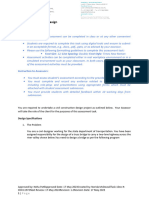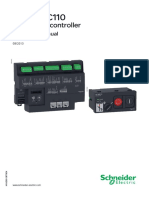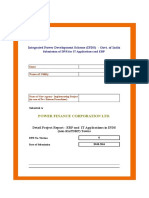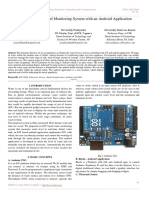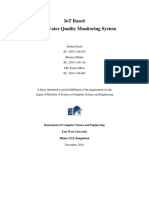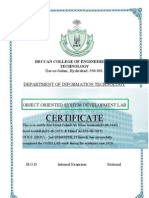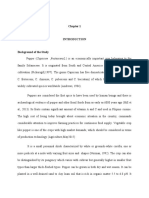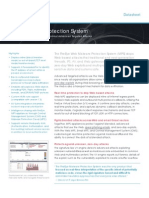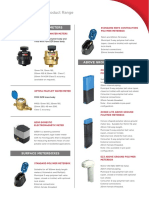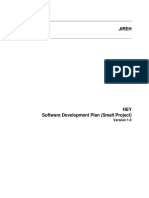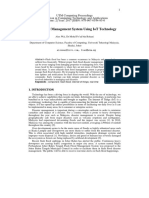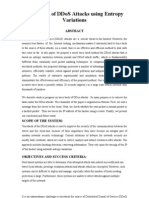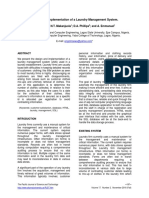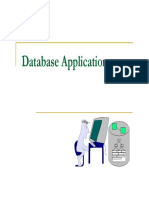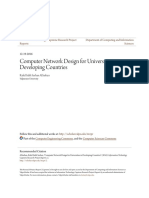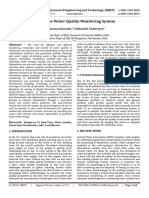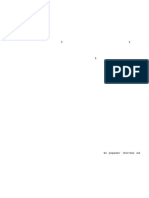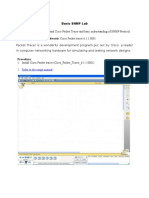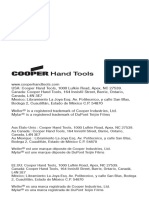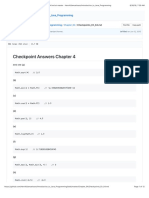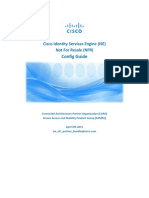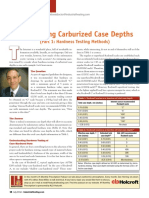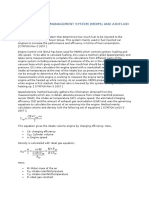IoT Based Real Time Water Monitoring System For Smart City
IoT Based Real Time Water Monitoring System For Smart City
Copyright:
Available Formats
IoT Based Real Time Water Monitoring System For Smart City
IoT Based Real Time Water Monitoring System For Smart City
Original Title
Copyright
Available Formats
Share this document
Did you find this document useful?
Is this content inappropriate?
Copyright:
Available Formats
IoT Based Real Time Water Monitoring System For Smart City
IoT Based Real Time Water Monitoring System For Smart City
Copyright:
Available Formats
Volume 3, Issue 4, April – 2018 International Journal of Innovative Science and Research Technology
ISSN No:-2456-2165
IOT Based Real time water Monitoring System for
Smart City
Rupalir. Shevale
Professor of Computer Department
Ndmvps's Kbtcoe Nashik
Savitribai Phule Pune University, Nashik.
Shweta Karad Maryam Merchant
Ndmvps's Kbtcoe Nashik Ndmvps's Kbtcoe Nashik
Savitribai Phule Pune University, Nashik. Savitribai Phule Pune University, Nashik.
Ashwini Kardile Vijeyata Mishra
Ndmvps's Kbtcoe Nashik Ndmvps's KBTCOE Nashik
Savitribai Phule Pune University, Nashik. Savitribai Phule Pune University, Nashik.
Abstract:- Water is an important resource for life and its are usually cheaper than fixed networks. Now people can
existence. Nowadays, due to increase in migration from a have connectivity from anywhere and anytime for anything.
rural area to urban areas, the population in cities is The Internet of Things is being used in number of sectors,
increasing rapidly. To satisfy the water requirement and from automation, transportation, energy, healthcare,
water quality monitoring needs, we are proposing an financial services, wearable devices, security, agriculture to
approach which is based on IoT (Internet of Things). In nanotechnology.
this paper we present an IoT based model for water level
and quality monitoring. The data will be collected using B. Problem statement
sensors and accessed on real time basis through website.
The proposed system consist different sensors like water Existing water treatment systems cannot detect the
flow sensor, pH sensor, water control valve, water level dissolved contaminants such as chemicals. Using traditional
sensor and a raspberry PI 0W as a core controller. The approaches of monitoring water quality in the water
data received from the sensors is processed by a management system are not safe. Chlorinating is usually
microcontroller and sent to the cloud via a wireless used to protect micro-organisms. However, drinking too
communication module. much chlorinated water leads to Cancer and other diseases.
Thus, chlorine is considered as another contaminant as well
Keywords:- Water controlling, water quality monitoring, as pathogen and viruses. Moreover, there is no single
IoT, cloud computing, Ph sensor, water flow sensor, water instrument that can detect all the possible water parameters
level sensor, Raspberry Pi 0W. such as pH, temperature and conductivity. Thus, our model
will help curb water borne diseases by developing a real-
I. INTRODUCTION time online water quality monitoring system. With this
model we can detect all the possible water quality
Drinking water is becoming more harmful and parameters and availability of water in water tank.
contaminated due to urbanization, industrialization and
increase in population. Hence there is need of better C. Motivation of project
methodologies for monitoring the water quality. For
examining the water quality manual efforts were required Water Pollution is a major global problem. It has
for testing. Such approaches take longer time and no longer been surveyed that water pollution is the leading cause of
to be considered efficient. By focusing on the above issues deaths and diseases worldwide. The records show that more
our model develop a low cost system for real time than 14,000 people die daily worldwide. In India predictable
monitoring of the water quality in IOT environment. 580 people die of water pollution related illness every day.
In many developing countries, dirty or contaminated water
A. Internet of Things (IoT) is being used for drinking without any proper former
treatment. The main reason for this happening is the
The Internet of Things (IoTs) can be used for unawareness among public and administration and the lack
connecting objects like smartphones, Internet TVs, laptops, of water quality monitoring system which creates serious
computers, sensors and actuators to the Internet where the health related issues. Also natural phenomena also change
devices are linked together to enable new forms of the quality of water and results into contamination of water.
communication between things and people, and between The most important aspect for all living organisms is water
things themselves. Building IoTs has improved significantly and it is necessary to preserve water. So water quality
in the past few years. The number of devices connected to monitoring is fundamental step for protection of water
the internet are increasing day by day. The cost related with resources. Designing this system will help to monitor the
machine to machine communication over mobile networks quality of water based on information sensed by the sensors
IJISRT18AP99 www.ijisrt.com 246
Volume 3, Issue 4, April – 2018 International Journal of Innovative Science and Research Technology
ISSN No:-2456-2165
submerged in water tank in order to know the various
parameters of water. Using different sensors, this system can
collect various parameters from water, such as temperature,
pH, water level, water flow.
II. BLOCK DIAGRAM
III. LITERATURE SURVEY
YEAR PAPER NAME AUTHOR DESCRIPTION LIMITATION
2015 Design of water F Ntambi, C P Kruger, The system consist of 3 wireless Due to wireless transfer of data
IEEE management B J Silva, G P Hancke sensor sub-system. All sometimes delivery of data is
system communicate with each other not ensured.
wirelessly and send information to There are chances of loss of
gateway connected to a computer data.
which hosts the GUI.
2016 Smart water Sayali Wadekar, Water level sensor will provide the No quality monitoring is
IEEE management Vinayak Vakare, Ram level of water present in the water performed, so even if water is
using IoT Ratan Prajapati tank and according to the level of available in tank, without
water, water motor will performing quality check, water
automatically turn ON and OFF. will be supplied.
Data is displayed on android The application needs to be
application. downloaded and updated from
time to time.
017 An IoT based Joy Shah The paper focuses on water The model does not use water
IJIRSET model for smart distribution using water flow sensor level sensor, so the availability
water and water control valve will help in of water in the tank will not be
distribution with even distribution of water and known. People will not be
quality provide adequate amount of water. aware of unavailability of
monitoring water.
By considering the limitation of previous models of Quality monitoring will ensure supply of safe water. It
water management, our model overcomes the drawbacks as displays data on website, so using website over application
it includes use of cloud for storing the sensor data. This will ensures accessing the data more rapidly and from anywhere.
ensure safety of data and prevent data loss. Our model also
uses water level sensor which will give real time
information about the level of water in the water tank.
IJISRT18AP99 www.ijisrt.com 247
Volume 3, Issue 4, April – 2018 International Journal of Innovative Science and Research Technology
ISSN No:-2456-2165
IV. PROPOSED FRAMEWORK
In this proposed block diagram consist of several
sensors (temperature, Ph, conductivity, water level, water
flow) is connected to core controller. The core controller are
accessing the sensor values and processing them to transfer
the data through internet. Raspberry PI is used as a core
controller. The sensor data can be viewed on the website
using cloud computing.
Fig 3:- Temperature Sensor
C. Water level sensor
Water level sensor will help us decide if we have
enough quantity of water to be supplied. An ultrasonic wave
is triggered from the sensor and distance to target is
determined by calculating the time required after the echo is
returned. The sensor emits a high-frequency pulse, generally
in the 20 kHz to 200 kHz range, and then listens for the
echo. The pulse is transmitted in a cone, usually about 6° at
the apex.
Fig 1:- Architecture diagram of water management system
for smart city
A. Water quality sensor
The pH meter is used for the quality check if water
is safe for drinking. A balanced pH level is very important
for human health; it should be approximately equal to 7. It
gives Full range pH reading from 1.0 to 14.00. It gives a
Single reading and continuous reading modes.
Fig 4:- Water level Sensor
D. Water flow sensor
For continues, water flow rate measurement YF-
S201 can be used. It has operating temperature range of -
25C - 80C which is wide enough for our application to
operate successfully.
Fig 2:- Water quality Sensor
B. Temperature sensor
A device which gives temperature measurement as
an electrical signal is called as Temperature sensor. This
electrical signal will be in the form of electrical voltage and
is proportional to the temperature measurement.
Fig 5:- Water flow Sensor
IJISRT18AP99 www.ijisrt.com 248
Volume 3, Issue 4, April – 2018 International Journal of Innovative Science and Research Technology
ISSN No:-2456-2165
E. Water controlling valve are programmed with Node-RED they are presented in the
form of bricks. Thus the data stream passes from one
A solenoid valve is used as a water controlling treatment to the other (from one function to the other).
valve, it is a simple electromagnetic device that converts
electrical energy directly into linear mechanical motion. A It is easy to use flow-based programming
solenoid valve is the combination of a mechanical valve and environment that helps IoT developers interact with APIs
basic solenoid. So a solenoid valve has two parts namely and different services. As Node-RED includes node.js, it can
Electrical solenoid and a mechanical valve. A solenoid be run at the edge of the network or in the cloud. Over a
valve is an electromechanically operated valve. thousand flows and nodes exist in the Node-RED library
today, which enable connections to all kinds of devices and
services. A Node-RED flow works by passing messages
between the nodes.
Fig 6:- Water controlling valve
F. Cloud
The sensors are controlled by the Raspberry Pi
controller which is connected to the internet via Wi-Fi. Fig 7:- Node-RED Framework
Using the internet, Raspberry Pi sends and receives the data
or command to/from Cloud for performing the real-time V. SYSTEM SETUP AND ACCESS
operation. A user can control system using web interface.
Steps to Access Website Offline
G. Microcontroller
STEP 1: Connect Raspberry-pi to access point.
The Raspberry Pi 0W is used as a microcontroller
in this system, it has 26 digital input/output pins which we STEP 2: Users must connect to the same network.
will use for connecting sensors-pH sensor, ultrasonic sensor,
Water flow sensor, temperature sensor and solenoid valves, STEP 3: Open browser and enter following URL:
and can be used as outputs, a USB connection and a power
192.168.43.140:1880/ui
jack is also present.
Raspberry Pi Zero W (Wireless) Details:
512MB RAM
Mini HDMI
USB On-The-Go port
Micro USB power
HAT-compatible 40-pin header
Composite video and reset headers
CSI camera connector
802.11b/g/n Wireless LAN
Bluetooth 4.1
Bluetooth Low Energy (BLE)
H. Node red
Node-RED is an Open Source project supported by Fig 8:- Offline GUI
IBM and is a graphical programming language used for
building connected objects. For wiring all the things
together in IoT Node-RED is used. When binder functions
IJISRT18AP99 www.ijisrt.com 249
Volume 3, Issue 4, April – 2018 International Journal of Innovative Science and Research Technology
ISSN No:-2456-2165
To deploy the system using node-red: I3= Water Flow sensor
Open browser and enter following URL I4= Water level sensor
192.168.43.140:1880 Function:
F= {F1, F2, F3}
F1= get sensor data
F2= store input data on cloud
F3= display data on website
Output:
O= {O1, O2}
O1= if water is contaminated the outlet of
water tank will be closed
O2= show data on webpage
Fig 9:- Node-RED deployment
Steps to access website online:
Open browser and enter following URL
http://iotcrunch.in/water/index.html
VII. CONCLUSION
In our proposed system, water quality monitoring is
presented. The proposed system is created with the use of
different sensors, Raspberry Pi 0W as controller and Cloud
for storing the data from Raspberry Pi and sending the
command to raspberry PI for measuring water quality and
water level. The generated data can be viewed using web
interface all over the city. The advantage of the system is to
provide the adequate water supply with good quality water
to each house, industry, and others. The proposed model can
be implemented as a part of the smart city.
Fig 10:- Website
VIII. ACKNOWLEDGMENT
VI. MATHEMATICAL MODEL
It gives us great pleasure in presenting the
Let S be a Water Monitoring System such that preliminary project report on IoT Based Real Time Water
Monitoring System For Smart City. We express our heartily
S= {I, O, F} gratitude towards Prof. R. R. Shevale for guiding us to
I= set of inputs understand the work conceptually and also for her constant
encouragement to complete this Project work on ” IoT
O= set of outputs Based Real Time Water Monitoring System For Smart
City”. We also express our thanks to Dr. V. S. Pawar, Head
F= set of functions of Deparment of Computer Engineering for providing
necessary information and required resources. With deep
Input: Sensor Data
sense of gratitude, we thank to our Principal Prof. Dr. K. S.
I= {I1, I2, I3, I4} Holkar and Management of the NDMVP Samaj’s for
providing all necessary facilities and their constant
I1= Water quality sensor encouragement and support.
I2= Temperature sensor
IJISRT18AP99 www.ijisrt.com 250
Volume 3, Issue 4, April – 2018 International Journal of Innovative Science and Research Technology
ISSN No:-2456-2165
REFERENCES
[1]. Sayali Wadekar, Vinayak Vakare, Ramaratan Prajapati,
”Smart water man- agement using IoT”, IEEE pp: 978-
15090,2016.http://ieeexplore.ieee.org/document/799342
5/.
[2]. F Ntambi, CP Kruger, BJ Silva and GP Hancke,
”Design of a water man- agement system”, IEEE
pp.97814799,2015.http://ieeexplore.ieee.org/iel7/73182
35/7331857/07332012.pdf.
[3]. N Vijaykumar, R Ramya, ”The real time monitoring of
water quality in IoT environment”, IEEE pp: 978-1-
47996818,2015.https://www.ijirset.com/upload/2016/m
arch/246_The_new.pdf.
[4]. Joy Shah, An Internet of Things Based Model for Smart
Water Distribution with Quality Monitoring,
International Journal Of Innovative Research In
Science, Engineering And Technology,
2017.https://www.ijirset.com/upload/2017/march/74_A
n_Internet.pdf.
[5]. Patawala Amatulla, Bansode Navnath, Bhong Yogesh,
”IOT Based Water Management System for Smart
City”, International Journal Of Advance Research,
Ideas And Innovations In Technology,
2017.https://www.ijariit.com/manuscripts/v3i2/V3I2-
1252.pdf.
IJISRT18AP99 www.ijisrt.com 251
You might also like
- Revised Task 1 RIICWD601Document5 pagesRevised Task 1 RIICWD601jekolaf936No ratings yet
- 2023 Syllabus Advanced Database SystemDocument10 pages2023 Syllabus Advanced Database Systemmasterken018No ratings yet
- An Analysis of Customer Retention and Insurance Claim Patterns Using Data Mining: A Case StudyDocument11 pagesAn Analysis of Customer Retention and Insurance Claim Patterns Using Data Mining: A Case StudyH.A. Caldera100% (1)
- Guideline Qualification of Equipment Annex 9 PH-meter October 2015Document4 pagesGuideline Qualification of Equipment Annex 9 PH-meter October 2015Parkhomyuk50% (2)
- SC-MI 20 Modelo RelesDocument70 pagesSC-MI 20 Modelo RelesRicardo MartinNo ratings yet
- Statement of Applicability For ISMS - IsO 27001Document5 pagesStatement of Applicability For ISMS - IsO 27001pvendaraNo ratings yet
- Field Welding of Steel Water Pipe: AWWA StandardDocument28 pagesField Welding of Steel Water Pipe: AWWA Standardaes nazNo ratings yet
- Model Dpr-It ErpDocument46 pagesModel Dpr-It ErpdiwakarNo ratings yet
- Software LicenseDocument3 pagesSoftware Licenserohanr18No ratings yet
- Chapter 6 - Transition To System DesignDocument54 pagesChapter 6 - Transition To System DesignGagan Chandel0% (1)
- Essential Kanji Basic Japanese ChaDocument8 pagesEssential Kanji Basic Japanese ChaDoriCraft25% (4)
- Managed Security Services by FortinetDocument37 pagesManaged Security Services by FortinetselenitalindissNo ratings yet
- IoT Based Water Level Monitoring System With An Android ApplicationDocument4 pagesIoT Based Water Level Monitoring System With An Android ApplicationEditor IJRITCCNo ratings yet
- IoT Based Smart Water Quality Monitoring SystemDocument38 pagesIoT Based Smart Water Quality Monitoring SystemEmran Emon100% (2)
- Android Based Course Learning Materials Application For Computer Science Students85bc40vwd6Document10 pagesAndroid Based Course Learning Materials Application For Computer Science Students85bc40vwd6olami lekanNo ratings yet
- Securing Water and Wastewater Utilities - Risk & SecurityDocument18 pagesSecuring Water and Wastewater Utilities - Risk & SecurityMoses NdimeleNo ratings yet
- Oosd - Cellular Networking Case StudyDocument54 pagesOosd - Cellular Networking Case StudyMohd Zohaib Ali Khan Amanzai100% (1)
- Thesis ProposalDocument8 pagesThesis ProposalKaren Revano ParagasNo ratings yet
- List of Computer Science Project TopicsDocument3 pagesList of Computer Science Project TopicsMangesh Kherdekar100% (1)
- Analytical Survey On Bug Tracking SystemDocument10 pagesAnalytical Survey On Bug Tracking SystemInternational Journal of Computer and Communication System EngineeringNo ratings yet
- Chapter 3Document11 pagesChapter 3Paolo RenNo ratings yet
- FireEye Web Malware Protection System Stops Web-Based AttacksDocument2 pagesFireEye Web Malware Protection System Stops Web-Based AttacksFireEyeNo ratings yet
- Smart Energy Water Metering Product Range PDFDocument2 pagesSmart Energy Water Metering Product Range PDFDominic Kibet-TooNo ratings yet
- Software Deployment Plan PDFDocument8 pagesSoftware Deployment Plan PDFYessi RomeroNo ratings yet
- IoT Based Agriculture Field MonitoringDocument45 pagesIoT Based Agriculture Field MonitoringakashlogicNo ratings yet
- Flash Flood Management System Using IoT TechnologyDocument6 pagesFlash Flood Management System Using IoT TechnologyDozo PowerNo ratings yet
- Design and Implementation of Online Sales and Inventory Management System (A Case Study of E-Bookshop)Document11 pagesDesign and Implementation of Online Sales and Inventory Management System (A Case Study of E-Bookshop)David TombeNo ratings yet
- A SEMINAR REPORT Tele-Immersion 1gowDocument25 pagesA SEMINAR REPORT Tele-Immersion 1gowSunil RAYALASEEMA GRAPHICSNo ratings yet
- Module 1 Unit 2 - Hardware and Software MGT PDFDocument7 pagesModule 1 Unit 2 - Hardware and Software MGT PDFRose Bella Tabora LacanilaoNo ratings yet
- Smart Irrigation SystemDocument40 pagesSmart Irrigation Systemshital shermaleNo ratings yet
- The Development of Electronic Health Record For Aldersgate College School Clinic Using SCRUM Framework of Agile MethodologyDocument78 pagesThe Development of Electronic Health Record For Aldersgate College School Clinic Using SCRUM Framework of Agile MethodologyCAPINPIN SerelynNo ratings yet
- Web Based Open Tender System For KIoTDocument93 pagesWeb Based Open Tender System For KIoTHaile michael100% (2)
- Tourist Monitoring System of Hulugan FallsDocument132 pagesTourist Monitoring System of Hulugan FallsJasper Cedrick Lorenzo AbellaNo ratings yet
- 2.0 Updated CapstoneDocument33 pages2.0 Updated CapstoneArianne Kaye AlalinNo ratings yet
- Wireless Network Lecture 1Document42 pagesWireless Network Lecture 1Sayed Maseer Zuhoori100% (1)
- Traceback of DDoS Attacks Using Entropy Variations AbstractDocument3 pagesTraceback of DDoS Attacks Using Entropy Variations AbstractJason StathamNo ratings yet
- Capstone DocumentDocument51 pagesCapstone DocumentJoe ComerNo ratings yet
- Final DocumentationDocument99 pagesFinal DocumentationIgnis Dustiness FordNo ratings yet
- An Automated System For Patient Record ManagementDocument7 pagesAn Automated System For Patient Record ManagementRonnie Oliva MalalisNo ratings yet
- Design and Implementation of A Laundry MDocument8 pagesDesign and Implementation of A Laundry MPamela LopezNo ratings yet
- Design and Implementation of Security Management Using Data Encryption and Decryption Techniquesfjo1nr4mfDocument12 pagesDesign and Implementation of Security Management Using Data Encryption and Decryption Techniquesfjo1nr4mfjamessabraham2100% (1)
- Project Proposal Shop Security System: Microcontroller Based DesignDocument6 pagesProject Proposal Shop Security System: Microcontroller Based DesignUsamaNo ratings yet
- Home Automation Using TelegramDocument28 pagesHome Automation Using TelegramNaveen DhaaramNo ratings yet
- Database Applications PDFDocument34 pagesDatabase Applications PDFRuthryi KulasekaranNo ratings yet
- Chapter 3Document9 pagesChapter 3Michael KitNo ratings yet
- A Smart Manhole Monitoring and Detection SystemDocument10 pagesA Smart Manhole Monitoring and Detection SystemIJRASETPublicationsNo ratings yet
- Executive Summary IWMS Business CaseDocument1 pageExecutive Summary IWMS Business CaseRadit AdiNo ratings yet
- Experiment:-1 (Role of Software) : ObjectiveDocument6 pagesExperiment:-1 (Role of Software) : ObjectiveRahul goume100% (1)
- Smart ClassroomDocument4 pagesSmart ClassroomInternational Journal of Innovative Science and Research TechnologyNo ratings yet
- Courier Management SystemDocument25 pagesCourier Management SystemRajmani Yadav67% (3)
- Faculty of Graduate Studies and Research Master of Science in Information TechnologyDocument31 pagesFaculty of Graduate Studies and Research Master of Science in Information TechnologyAyola JayamahaNo ratings yet
- Applying Data Mining To Customer Churn Prediction in An Internet Service ProviderDocument7 pagesApplying Data Mining To Customer Churn Prediction in An Internet Service Providerthomas.bhatiaNo ratings yet
- Computer Network Design For Universities in Developing CountriesDocument88 pagesComputer Network Design For Universities in Developing CountriesAhmed JahaNo ratings yet
- Disadvantages of Computer NetworksDocument2 pagesDisadvantages of Computer Networksmbok diyirNo ratings yet
- Agile Software Development: 5.1 Coping With ChangeDocument13 pagesAgile Software Development: 5.1 Coping With ChangeBharath KumarNo ratings yet
- Importance On IT On Electrical EnggDocument5 pagesImportance On IT On Electrical EnggKevin Cabante100% (1)
- QR Code Use in Smart Rooms Cleaning Management SystemDocument4 pagesQR Code Use in Smart Rooms Cleaning Management SystemInternational Journal of Innovative Science and Research TechnologyNo ratings yet
- PC Replacement PolicyDocument3 pagesPC Replacement PolicyChristopher GuestNo ratings yet
- Smart Parking SystemDocument36 pagesSmart Parking SystemSomething TrickyNo ratings yet
- Enhancing Cybersecurity Through Advanced Techniques in NetworkIntrusion Detection SystemsDocument4 pagesEnhancing Cybersecurity Through Advanced Techniques in NetworkIntrusion Detection SystemsInternational Journal of Innovative Science and Research TechnologyNo ratings yet
- Attendance Monior System Using Smart CardsDocument58 pagesAttendance Monior System Using Smart Cardsarj2640% (2)
- Web-Based Document Management System For AACUP CIT CampusDocument56 pagesWeb-Based Document Management System For AACUP CIT CampusCharmaine Agtarap AgpaoaNo ratings yet
- Online Payment of Electric Bills SystemDocument6 pagesOnline Payment of Electric Bills SystemBradley Alano Delos SantosNo ratings yet
- Student Attendance Online System Using Bar CodeDocument24 pagesStudent Attendance Online System Using Bar Codevikramrock100% (1)
- SSRN 3904842Document7 pagesSSRN 3904842shuklashreyanshu04No ratings yet
- Irjet V5i3265Document6 pagesIrjet V5i3265abhisheknarendar27No ratings yet
- Iot Based Smart Water Quality Monitoring System: Ms. Minal MadnaniDocument4 pagesIot Based Smart Water Quality Monitoring System: Ms. Minal Madnanirahul shreevastavNo ratings yet
- Adapting 'Rishi-Krishi' Perspectives in Safe Farming in Aadhikhola, Gandaki Province, NepalDocument10 pagesAdapting 'Rishi-Krishi' Perspectives in Safe Farming in Aadhikhola, Gandaki Province, NepalInternational Journal of Innovative Science and Research Technology100% (1)
- Examining How Police as a Security Function Fosters Socio-Economic Development in KenyaDocument16 pagesExamining How Police as a Security Function Fosters Socio-Economic Development in KenyaInternational Journal of Innovative Science and Research TechnologyNo ratings yet
- Nurses’ Knowledge Regarding Management of Burn Injury Patients at Selected Hospital in Dhaka, BangladeshDocument16 pagesNurses’ Knowledge Regarding Management of Burn Injury Patients at Selected Hospital in Dhaka, BangladeshInternational Journal of Innovative Science and Research TechnologyNo ratings yet
- Determinants of the Exploitation of Groundwater Resources of the Alluvial Plain of KarfiguelaDocument4 pagesDeterminants of the Exploitation of Groundwater Resources of the Alluvial Plain of KarfiguelaInternational Journal of Innovative Science and Research TechnologyNo ratings yet
- Optimizing Maternal Nutrition and its Impact on Fetal Development: Evidence-Based Insights and Current GuidelinesDocument4 pagesOptimizing Maternal Nutrition and its Impact on Fetal Development: Evidence-Based Insights and Current GuidelinesInternational Journal of Innovative Science and Research TechnologyNo ratings yet
- Application of Gestalt Theory in Interior Design Dinas Perpustakaan Dan Kearsipan Daerah Provinsi Jawa Barat (DISPUSIPDA)Document10 pagesApplication of Gestalt Theory in Interior Design Dinas Perpustakaan Dan Kearsipan Daerah Provinsi Jawa Barat (DISPUSIPDA)International Journal of Innovative Science and Research TechnologyNo ratings yet
- Fatigue Failure Analysis of Notched Specimen with En19, En354 and En36c MaterialsDocument7 pagesFatigue Failure Analysis of Notched Specimen with En19, En354 and En36c MaterialsInternational Journal of Innovative Science and Research TechnologyNo ratings yet
- Functionality of Google Maps and Parameter-based Efficient Eateries route DetectionDocument8 pagesFunctionality of Google Maps and Parameter-based Efficient Eateries route DetectionInternational Journal of Innovative Science and Research TechnologyNo ratings yet
- Perception of Victim Blaming: Basis for Community EducationDocument6 pagesPerception of Victim Blaming: Basis for Community EducationInternational Journal of Innovative Science and Research TechnologyNo ratings yet
- A Field Survey to Investigate the Flora of Dharmashala Dhauladhar Range in North-Western Himalayan Region of IndiaDocument13 pagesA Field Survey to Investigate the Flora of Dharmashala Dhauladhar Range in North-Western Himalayan Region of IndiaInternational Journal of Innovative Science and Research TechnologyNo ratings yet
- Chronic Low-Grade Systemic Inflammatory State and Insulin Resistance: Implications for Metabolic HealthDocument14 pagesChronic Low-Grade Systemic Inflammatory State and Insulin Resistance: Implications for Metabolic HealthInternational Journal of Innovative Science and Research TechnologyNo ratings yet
- Aetiology of Hearing Loss in Cochlear Implantees: A Study of 191 Cases at CI Centre, CMH, DhakaISRT24DEC453Document6 pagesAetiology of Hearing Loss in Cochlear Implantees: A Study of 191 Cases at CI Centre, CMH, DhakaISRT24DEC453International Journal of Innovative Science and Research TechnologyNo ratings yet
- A Study at Bal Rugnalay in Paratwadha Maharastra to Provide Teaching Program Plan and to Assess Effectiveness of Non Nutritive Sucking or Pacifier in Promoting Physiologic Stability and Nutritional Status among Preterm Infants Admitted in NICUDocument7 pagesA Study at Bal Rugnalay in Paratwadha Maharastra to Provide Teaching Program Plan and to Assess Effectiveness of Non Nutritive Sucking or Pacifier in Promoting Physiologic Stability and Nutritional Status among Preterm Infants Admitted in NICUInternational Journal of Innovative Science and Research TechnologyNo ratings yet
- Effect of Nanotechnology in Orthodontic Materials : An OverviewDocument6 pagesEffect of Nanotechnology in Orthodontic Materials : An OverviewInternational Journal of Innovative Science and Research TechnologyNo ratings yet
- Vocabulary Proficiency and Reading Comprehension of Senior High School Students: Basis for the Development of Supplementary Learning MaterialDocument9 pagesVocabulary Proficiency and Reading Comprehension of Senior High School Students: Basis for the Development of Supplementary Learning MaterialInternational Journal of Innovative Science and Research TechnologyNo ratings yet
- Perceived Cognitive Skills in Chemistry through Case-Based Learning ApproachDocument17 pagesPerceived Cognitive Skills in Chemistry through Case-Based Learning ApproachInternational Journal of Innovative Science and Research TechnologyNo ratings yet
- Exploring the Role of Human Behavior Analytics in Strengthening Privacy-Preserving Systems for Sensitive Data ProtectionDocument16 pagesExploring the Role of Human Behavior Analytics in Strengthening Privacy-Preserving Systems for Sensitive Data ProtectionInternational Journal of Innovative Science and Research TechnologyNo ratings yet
- Technological Innovations in Osteoporosis Diagnosis and their Implications for Bone Metastases Management in OncologyDocument15 pagesTechnological Innovations in Osteoporosis Diagnosis and their Implications for Bone Metastases Management in OncologyInternational Journal of Innovative Science and Research TechnologyNo ratings yet
- The Important Role of Information Systems Auditing in Compliance and Risk Management ReviewDocument6 pagesThe Important Role of Information Systems Auditing in Compliance and Risk Management ReviewInternational Journal of Innovative Science and Research TechnologyNo ratings yet
- Optimising Web Application Development Using Ruby on Rails, Python, and Cloud-Based ArchitecturesDocument10 pagesOptimising Web Application Development Using Ruby on Rails, Python, and Cloud-Based ArchitecturesInternational Journal of Innovative Science and Research TechnologyNo ratings yet
- Estimation of Input Vector Pair from Embedded Space Vector Corresponding to the Framework Based on Spacer Component Matrices: A Constrained Optimization based ApproachDocument13 pagesEstimation of Input Vector Pair from Embedded Space Vector Corresponding to the Framework Based on Spacer Component Matrices: A Constrained Optimization based ApproachInternational Journal of Innovative Science and Research TechnologyNo ratings yet
- Review on Diagnosis and Management of Dehydration in children and Adolescent Age between (6 To 18)’’Document3 pagesReview on Diagnosis and Management of Dehydration in children and Adolescent Age between (6 To 18)’’International Journal of Innovative Science and Research TechnologyNo ratings yet
- The Impact of Infectious Diseases on Global Health Systems: Challenges and Strategies for PreventionDocument7 pagesThe Impact of Infectious Diseases on Global Health Systems: Challenges and Strategies for PreventionInternational Journal of Innovative Science and Research TechnologyNo ratings yet
- Forensic Documents Examination: A Rescue Mission to Obviate a Catastrophic ExtinctionDocument13 pagesForensic Documents Examination: A Rescue Mission to Obviate a Catastrophic ExtinctionInternational Journal of Innovative Science and Research TechnologyNo ratings yet
- The Impact of the Proposed Military and Uniformed Personnel Pension System Bill on the Philippine National Police: Basis for an Intervention MeasureDocument15 pagesThe Impact of the Proposed Military and Uniformed Personnel Pension System Bill on the Philippine National Police: Basis for an Intervention MeasureInternational Journal of Innovative Science and Research TechnologyNo ratings yet
- A Cost and Return Analysis: Assessing the Economic Viability and Challenges of Mulberry Cocoon Production in Coimbatore District, Tamil NaduDocument8 pagesA Cost and Return Analysis: Assessing the Economic Viability and Challenges of Mulberry Cocoon Production in Coimbatore District, Tamil NaduInternational Journal of Innovative Science and Research TechnologyNo ratings yet
- GSM based Home Security Alert Alarm System using ArdinoDocument7 pagesGSM based Home Security Alert Alarm System using ArdinoInternational Journal of Innovative Science and Research TechnologyNo ratings yet
- Prediction of Tool Life During Turning Process Using Cemented Carbide ToolDocument8 pagesPrediction of Tool Life During Turning Process Using Cemented Carbide ToolInternational Journal of Innovative Science and Research TechnologyNo ratings yet
- Gen AI based Catering Management SystemDocument6 pagesGen AI based Catering Management SystemInternational Journal of Innovative Science and Research TechnologyNo ratings yet
- Lived Experiences of Children with Incarcerated Parents: A Phenomenological StudyDocument29 pagesLived Experiences of Children with Incarcerated Parents: A Phenomenological StudyInternational Journal of Innovative Science and Research TechnologyNo ratings yet
- Basic SNMP LabsDocument10 pagesBasic SNMP LabsSyed Imran Ali Kazmi0% (1)
- Cisco IOS Commands Master List, Release 12.2: Page Number DesignatorsDocument74 pagesCisco IOS Commands Master List, Release 12.2: Page Number DesignatorsKarim JiwaniNo ratings yet
- Principles of Cost ControlDocument4 pagesPrinciples of Cost ControlBaguma Grace GariyoNo ratings yet
- Weller Project BookDocument7 pagesWeller Project BookCynthia MillerNo ratings yet
- Purging and Archiving Work ObjectsDocument35 pagesPurging and Archiving Work Objectssaratchandra1225No ratings yet
- Arquitectura Empresarial Una Vision GeneralDocument12 pagesArquitectura Empresarial Una Vision Generalrexim93284No ratings yet
- 2002 Cameron Replacement Parts CatalogDocument142 pages2002 Cameron Replacement Parts Cataloggfabela100% (8)
- ECP 11-0008 LV Cable Testing ProcedureDocument9 pagesECP 11-0008 LV Cable Testing Procedurerobertovm2002No ratings yet
- Sample LIA Template: Part 1: Purpose TestDocument5 pagesSample LIA Template: Part 1: Purpose TestNiranjan JeyakumarNo ratings yet
- Modular Shoring System 2008Document36 pagesModular Shoring System 2008VaishamNo ratings yet
- Checkpoint Answers Chapter 4: Introduction - To - Java - ProgrammingDocument12 pagesCheckpoint Answers Chapter 4: Introduction - To - Java - ProgrammingKevin NgoNo ratings yet
- ISE 1.3 GuideDocument54 pagesISE 1.3 GuideSunny JamNo ratings yet
- Interpreting Carburized Case DepthsDocument4 pagesInterpreting Carburized Case Depthsmp87_ing100% (1)
- Electronicos 2Document21 pagesElectronicos 2CT AnthonyNo ratings yet
- 6S1 Sound AttenuatorsDocument20 pages6S1 Sound AttenuatorsTaha Morad100% (1)
- CP342-5 DP Master Slave enDocument12 pagesCP342-5 DP Master Slave enmateoNo ratings yet
- CV - Elchin SalimovDocument3 pagesCV - Elchin SalimovMicRoToneNo ratings yet
- Civil Works Components of Information Technology ProjectsDocument6 pagesCivil Works Components of Information Technology ProjectsedpaalaNo ratings yet
- DH Hac Hfw1200r Z Ire6 Datasheet 20180718Document3 pagesDH Hac Hfw1200r Z Ire6 Datasheet 20180718Sebastian Acevedo GomezNo ratings yet
- Modular Engine Management System (Mems) and Air/Fluid ControlDocument2 pagesModular Engine Management System (Mems) and Air/Fluid ControlocernnNo ratings yet
- NS - QAP-001 - Quality Assurance Provisions (QAPs) v6 - 0Document36 pagesNS - QAP-001 - Quality Assurance Provisions (QAPs) v6 - 0Suleman KhanNo ratings yet
- Project Power PlantDocument61 pagesProject Power PlantKumaresh ChatterjeeNo ratings yet
